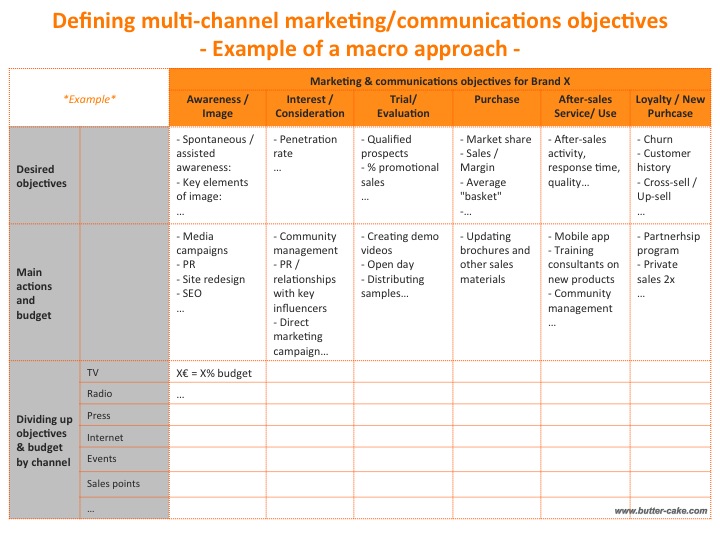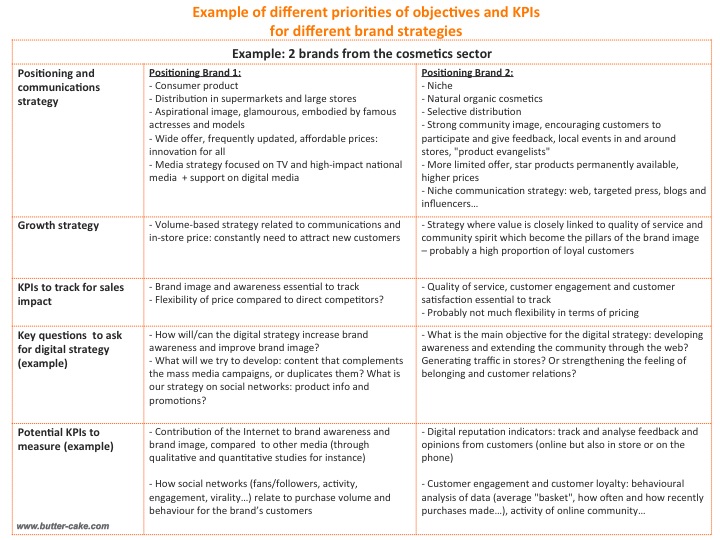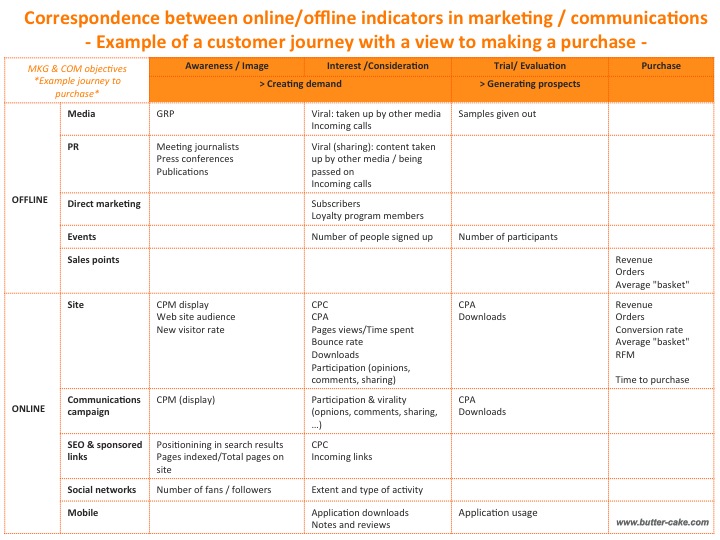Overview: The two main problems relating to the strategic management of digital actions are linked: an excess of available data and the difficulty of aggregating them with actions carried out on other media. This is the starting viewpoint that distorts the situation: if we start focusing on operations and what is measurable, any additions or comparisons will be shortsighted and made at the wrong level. We need to start from strategic objectives and criteria for success and failure to define the right indicators, and to avoid confusing indicators relating to goals with tactical indicators.
Unlike other media, the Internet doesn’t exactly suffer from a lack of data or traceability – quite the contrary! It provides so much data and so many indicators that the risk is more one of going “measuring-crazy” in a way that is of no more help than their total absence, as it creates bias. On the one hand, it can lead to too much importance being placed on quantative data at the expense of a qualitative assessment of the events measured; and on the other hand, it can restrict the freedom to stand back and reflect, any missing link between two pieces of information becoming problematic, to name but two.
However, a corporate strategy is not driven by CPM or CPA. Is it really useful to measure absolutely everything, or is it more a question of defining the right indicators based on the objectives sought? Is it useful to have hordes of indicators if we can’t get a view of how the different types of actions interact, not only on the web but also with other media and channels?
These two seemingly separate problems are linked because they both come from the same starting point: when we start at the operations level, comparing the web and TV (for instance) could give us the impression we are mixing apples and oranges, and may lead to endless debates. They can only be compared from the strategic perspective, looking to see at which level each action contributes, and how – both quantitatively and qualitivately. This way, we will find the right way to steer the project.
How to define the right indicators to track?
– The right indicators relate to goals
To know what we should measure, we shouldn’t start by looking at what we can measure, but rather by examining the results we want to achieve, and what our criteria of success and failure would be. At a company strategy level, this means that the role of the Internet, in its different components and possible contributions to strategy, has been clearly defined (with a margin of error and with slight room for adjustment based on feedback, of course).
This approach immediately makes the apparent singularity of any digital strategy stand out: the good and bad practices we can find described in abundance should serve only as a source of inspiration, never as a model to be applied literally (and the same goes for KPIs), since integration and the contribution of digital media to a company strategy can vary widely from one company to another, and from one possible strategy to another.
The example above, which is just a draft, illustrates three important elements:
– Digital strategy cannot be separated from other offline actions, as the two are intrinsically linked by consumer uses, which are multi-channel. Internet and mobile goals and targets must therefore be linked to strategic objectives if we want to know the level at which they are situated and how to compare them to other channels, before we put down our nose to the webanalytics grindstone.
– Measuring the contribution of the Internet to strategic goals is not something which happens only online, but must also be integrated into all consumer studies (qualitative and well as quantitative): this will also provide an interesting view of how the different channels contribute both compared to each other and over time.
– Not all brands need such a thorough approach in all aspects of marketing and communications: for some, a CRM program will be essential; others (such as Brand Number One in our example above) will see little interest compared to the strategy of image and innovation, which is the real driver of customer loyalty. The same is true for digital reputation: while it is important for all brands to know what is being said about them on the Internet, it is also true that not all of them will require the same degree of investment in software and community management, depending on their market, their size, and their sales strategy…
– Differentiating between KPIs relating to final objectives and tactical, intermediate KPIs
Depending on the strategy chosen, an indicator may be key for one company, and less important for another, as in the example above. For this reason, we need to be able to prioritise KPIs and differentiate between those relating to final objectives and those which are more tactical.
KPIs relating to final objectives are those which confirm the strategy chosen, the ultimate goal of which could be the sustainability of the company, its sale within 5 years or keeping its commitments (to shareholders, etc) in terms of sales targets, margin, profitability, financial stability… Once they have been defined by senior management, they are then broken down at a functional level in line with the strategy. For instance, for the marketing/communications department, they could relate to the reputation and image of the company, customer profile, how well and efficiently prospects are turned into customers, etc.
Intermediate KPIs are those we can check along the way to confirm that we are on the right track, but they should not be thought of as goals in themselves. They are tactical KPIs, not strategic ones. Confusion often exists between these two types of indicators, not least because of the mechanics of how businesses are run: what is simply a tactical indicator for a senior manager may become a goal for her direct report! Working like this may make it easier to create dashboards at the beginning of the year or set annual objectives for employees, but it also means that the company can become blinkered in a way that prevents it from changing tactics en route! The final objective should be the same for all employees, whatever their position in the hierarchy of the department. It isn’t the goal that needs to be adjusted at different hierarchical levels, but the room for manoeuvre that exists in the contribution required to achieve it. Tactical indicators can show both the “right” track and the “wrong” track: thresholds for alerts, levels under which certain measurements should not fall, etc.
Once objectives have been clearly defined, allocated to each media/channel at the strategic level and broken down at the tactical level, they can then be combined into a dashboard that will enable them to be tracked and compared over time.
How (and at what pace) to steer a project?
How to steer a project is something that can be defined retrospectively in relation to the strategic goals to be achieved, not from the data available at the moment: we move forward by looking at the distance to the horizon, not by looking down at our feet! What may seem obvious is in fact a mistake that is commonly made, often as a result of strong internal pressure to “show” results. The problem is that if you spend all your time looking down at your feet, you may have the impression that you’re moving quickly, but you may also end up walking right into a wall…
Some useful indications to help decide on the right pace for steering a project include:
– The constraints to which the company’s external communications are subject, which define how often the strategic objectives need to be checked: for instance, publicly-traded companies are obliged to communicate on a quarterly basis, which could be a good minimum for checking KPIs. If we check more regularly than that, we risk moving away from strategic steering to the tracking of tactical indicators.
– The frequency with which the different data is collected and made available for anaylsis. How easily and how quickly certain data can be collected on the Internet can allow for a more regular monitoring during the launch phase, for instance, or during the test phase, but this should not be used to create an artificial “rush” that contributes to one of the misconceptions that exist about the Internet: no, everything is not immediate – the customers or clients on the other side are the same human beings, whether they are clicking a link or passing in front of your store. As part of a communications campaign, for instance, TV or radio audiences are measured after several months, and the same is true for measuring brand awareness or brand image. We need to know beforehand what we expect from each level and frequency of measurement, to be sure that we don’t miss our target, and to remain measured in our judgement: we mustn’t move too quickly, but we mustn’t wait too long before making adjustments either.
– The time required for the different actions to be put in place and have an impact, which is related to the possibility to correct them: if there’s no solution, there’s no problem. There is no point in measuring actions if we can’t do anything about them. For instance, setting up actions aimed at improving SEO could take quite some time before they have a visible impact, and we need to accept that we will have to wait to see the results before changing strategy again. Even buying key words can take a few weeks, for instance, depending on how long you have been a client of Google. We mustn’t forget that dashboards and scorecards are tools to help manage an activity, and they are not the activity itself: setting up a rate for reporting that is faster than the time needed for the actions to take effect can create internal pressure to produce figures in a way that means teams spend more time filling out Excel spreadsheets than working on the actions themselves, and can even lead to decisions being taken simply to be able to complete a scorecard on time.
In conclusion, you don’t need to be a web expert to set up good KPIs for your objectives and to steer a strategy. It is a question of common sense and logic, which requires the strategy and the priorities to be clearly defined. The right level of tactical indicators for monitoring the different actions may require more extensive web expertise, in particular knowledge of the different tools available, but this should not lead to madly “measuring everything” or you risk losing track of the real objective. Benchmarks and case studies available on the market can be especially useful and interesting when launching new actions – it is up to the company to apply its own experience and establish its own internal criteria, which is the only way it can be sure to follow its own path rather than being forever dependent on trends and the strategies of others.
The following and final article of this series focuses on how to integrate digital innovation in a permanent way to a digital communication strategy. The entire series is regrouped in the ebook « Building a digital strategy », available for download in PDF format on this site.



